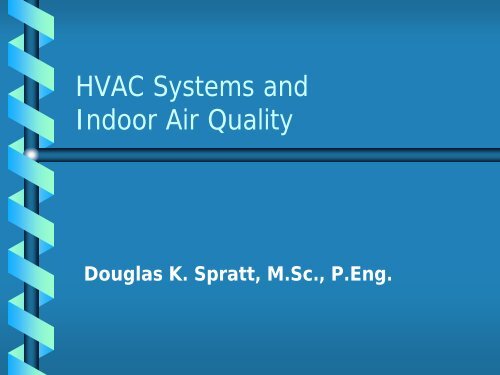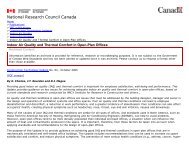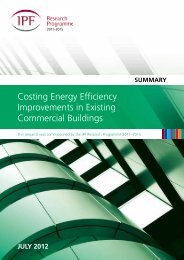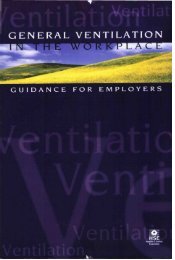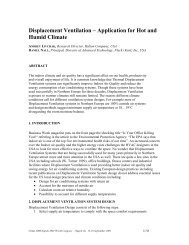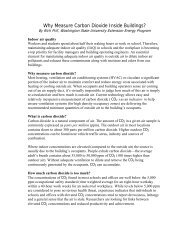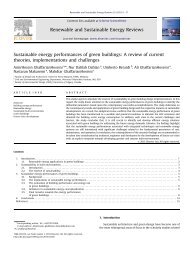HVAC Systems and Indoor Air Quality
HVAC Systems and Indoor Air Quality
HVAC Systems and Indoor Air Quality
Create successful ePaper yourself
Turn your PDF publications into a flip-book with our unique Google optimized e-Paper software.
<strong>HVAC</strong> <strong>Systems</strong> <strong>and</strong><br />
<strong>Indoor</strong> <strong>Air</strong> <strong>Quality</strong><br />
Douglas K. Spratt, M.Sc., P.Eng.
The 5 Senses<br />
Architecture Electrical Structural<br />
Mechanical<br />
Hearing<br />
Seeing<br />
Smelling<br />
Feeling<br />
Tasting
<strong>HVAC</strong> <strong>Systems</strong> are Dynamic<br />
Heat Gains<br />
Solar<br />
Response<br />
Loads<br />
Outdoor<br />
temperature<br />
Lights<br />
Required <strong>Air</strong><br />
Conditioning<br />
People<br />
Equipment
Presentation Agenda<br />
❂ Why We Have <strong>HVAC</strong> <strong>Systems</strong><br />
❂ Definitions<br />
❂ <strong>HVAC</strong> Control Strategies<br />
❂ <strong>HVAC</strong> Pollutant<br />
❂ <strong>HVAC</strong> <strong>Systems</strong>
The Purpose of <strong>HVAC</strong><br />
<strong>Systems</strong><br />
H<br />
V<br />
A<br />
Thermal Control (ASHRAE - 55)<br />
<strong>Air</strong> <strong>Quality</strong> (ASHRAE - 62)<br />
(Contaminant Control)<br />
C<br />
<strong>HVAC</strong> = Artificial Environment
The IAQ Lexicon<br />
❂<br />
Acceptable IAQ:<br />
1. No known contaminants of harmful<br />
Concentration (objective)<br />
2. >80% people satisfied with air quality<br />
(subjective)<br />
❂<br />
Sick Building Syndrome:<br />
1. > 20% people complaining over 2 weeks<br />
2. Symptoms only occur when in building<br />
➧ Headaches<br />
➧ Fatigue<br />
➧ Nausea<br />
➧ Eye irritation<br />
➧ Throat irritation
More Definitions<br />
❂ cfm: cubic feet per minute (flow rate)<br />
cfm/person - usually refers to outdoor air<br />
❂ ACH: <strong>Air</strong> Change Rate (per hour)<br />
Example:<br />
Office 10’ x 10’ x 8’ high, with one person<br />
Supply air<br />
= 120 cfm<br />
Outdoor air = 20% of S/A = 24 cfm/person<br />
<strong>Air</strong> change<br />
= (120ft 3 /min)÷(10x10x8/) x 60 min/h<br />
= 9 ACH
More Definitions<br />
❂ Conscienceness: that annoying state<br />
in between naps.<br />
❂ Dopelar effect: the tendency of<br />
stupid ideas to seem smarter when<br />
you come at them rapidly.
<strong>HVAC</strong> Control Strategies<br />
❂ Outline<br />
• Ventilation<br />
• <strong>Air</strong> Cleaning<br />
• Humidification
Ventilation<br />
- removes emissions<br />
Source<br />
Emissions<br />
Reduce<br />
Remove
Two Contaminant<br />
Control Strategies<br />
1. Source Extraction<br />
2. Dilution
Source Extraction<br />
❂ When?<br />
❂ Design - Velocity (100 fpm)<br />
- Minimize Working Exposure<br />
- Make Up <strong>Air</strong>
Two Dilution Methods<br />
1. Natural • Operable Windows<br />
• Infiltration<br />
2. Mechanical • Exhaust<br />
• <strong>HVAC</strong> relief air <strong>and</strong><br />
outdoor air
Natural Ventilation<br />
❂ Advantages - Low 1st Cost<br />
- Low Maintenance<br />
- Natural (“green”)
Natural Ventilation<br />
❂ Disadvantages<br />
• Limited to Low Occupant Densities<br />
• Limited to Mild Climates<br />
• Poor Distribution<br />
• Uncontrollable factors
Natural Ventilation<br />
❂ Design<br />
• Cross Drafts<br />
• Stack Effects<br />
• Hybird <strong>Systems</strong>
Mechanical Ventilation<br />
❂ How much?<br />
❂ Depends on:<br />
• Type of Pollutants<br />
• Emission Rates<br />
• Ventilation Effectiveness
How Much Ventilation?<br />
❂ ASHRAE St<strong>and</strong>ard 62-89:<br />
• cfm O/A per person<br />
• or go “scientific”<br />
❂ Proposed Revision to 62-89<br />
● cfm/person + cfm/ft 2<br />
●<br />
i.e., people + building<br />
❂<br />
Other approaches:<br />
● Olf (the nose test)<br />
● exposure limits
People & Pollution<br />
❂ Some emission rates correlate to<br />
people’s activities<br />
❂ People consume oxygen<br />
❂ People can have diseases which are air<br />
borne<br />
❂ Carbon dioxide (CO 2 ) levels can be an<br />
indicator of overall indoor air quality
Mechanical Ventilation<br />
❂ Methods<br />
• Exhaust Fan<br />
• Exhaust With Make-Up <strong>Air</strong><br />
• Mixed Supply <strong>Air</strong><br />
– Fixed Dampers<br />
– Modulating Dampers
The Economizer Section<br />
EXHAUST<br />
RETURN<br />
RECIRCULATED<br />
OUTDOOR<br />
M-2<br />
MIXED<br />
SUPPLY<br />
M-1
Example<br />
20 ton Roof-top unit<br />
9,000 cfm supply<br />
1,000 cfm toilet exhaust<br />
9,000 ft 2 floor space<br />
Office space with 150 ft 2 /person<br />
62-89 O/A = 20 cfm/person x 9,000 ft 2<br />
150 ft 2 /person<br />
= 1,200 cfm
Ignoring Infiltration<br />
200 cfm<br />
1,000 cfm<br />
R/A 8,000 cfm<br />
7,800 cfm<br />
1,200 cfm<br />
S/A 9,000 cfm<br />
T/E<br />
% O/A = 1,200 cfm = 13%<br />
9,000 cfm
Mechanical Ventilation<br />
❂ Distribution Effectiveness<br />
• Grilles & Diffusers<br />
• Location
Ventilation Summary<br />
Source<br />
Emissions<br />
Removal<br />
Source<br />
Extraction<br />
Natural<br />
Dilution<br />
Mechanical
<strong>HVAC</strong> Control Strategies<br />
❂ Ventilation<br />
❂ <strong>Air</strong> Cleaning
Filters<br />
Gases<br />
Viruses<br />
Smoke<br />
Dust<br />
Pollens<br />
Micrometers<br />
0.001 0.01 0.1 1.0 10 100<br />
HEPA Filters<br />
90 % Filters<br />
80 % Filters<br />
60 % Filters<br />
30 % Filters
O/A<br />
R/A<br />
ASHRAE 52.1<br />
Test Procedure Efficiencies<br />
HEPA<br />
DOP<br />
Penetration Test<br />
Final<br />
(Bag/Cartridge) Atmospheric<br />
Dust-Spot<br />
Pre<br />
(Panel)<br />
Atmospheric<br />
Dust-Spot<br />
99.77% @ 0.3<br />
60-90%<br />
20-30%
Filter Types<br />
❂ St<strong>and</strong>ard (panel, pleated, bag, etc.)<br />
❂ Electrostatic<br />
❂ Sorption
<strong>HVAC</strong> Control Strategies<br />
❂ Ventilation<br />
❂ <strong>Air</strong> Cleaning<br />
❂ Humidification
Humidification<br />
❂ Desired Range 30 - 40%<br />
❂ Limitations<br />
❂ Means<br />
(Covered Later)<br />
Steam & Water
<strong>HVAC</strong> Pollutant Sources<br />
Source<br />
Emissions<br />
Reduce<br />
Remove
Ducts<br />
Sources:<br />
●<br />
●<br />
●<br />
●<br />
Acoustic Lining<br />
Ceiling Plenums<br />
Tenant Changes<br />
Dust <strong>and</strong> Moisture
Ducts<br />
❂ Strategies<br />
• Inspection<br />
• Cleaning<br />
• Sealing
Intakes<br />
❂ Proximity to Exhausts:<br />
• Kitchen<br />
• Flues<br />
• Vehicles<br />
• Smokers
Intakes<br />
❂ Strategies<br />
• Discharge Location<br />
• Terminus<br />
• Velocity
Moisture<br />
❂ Sources<br />
• Humidifiers<br />
• Cooling Towers<br />
• Cooling Coils<br />
• Uninsulated Ducts
Moisture<br />
❂ Strategies<br />
• Eliminate<br />
• Treat
Combustion<br />
❂ Sources<br />
• Faulty Heat Exchangers<br />
• Faulty Flues<br />
• Back Drafting
Combustion<br />
❂ Strategies<br />
• Inspection<br />
• Testing<br />
• O/A Control


